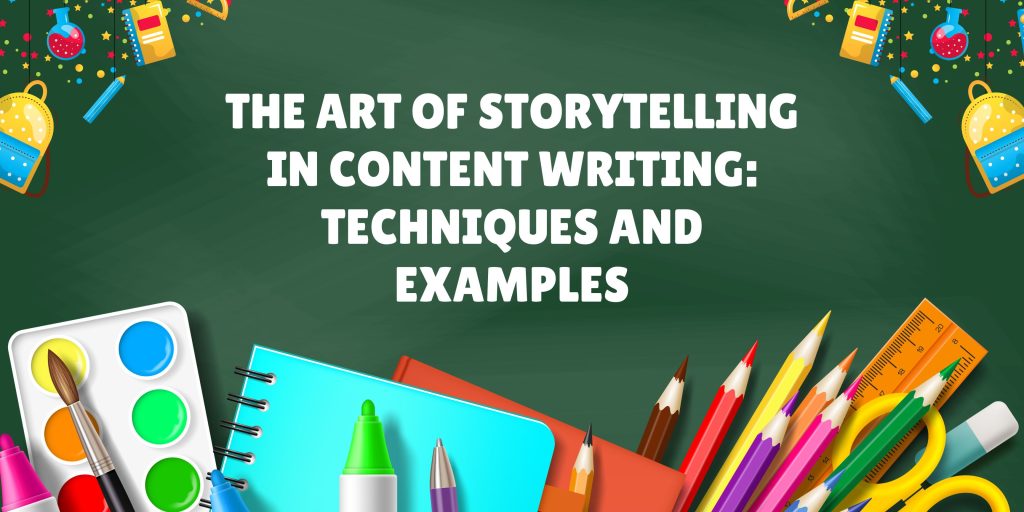Storytelling is a timeless and powerful form of communication that has been used for centuries to captivate, engage, and connect with audiences. In the realm of content writing, incorporating storytelling techniques can elevate your content and make it more compelling and memorable. By weaving narratives into your writing, you create an emotional connection with your readers and bring your content to life. In this blog post, we will explore the art of storytelling in content writing, delve into various storytelling techniques, and provide real-life examples to illustrate their impact.
- The Power of Emotion:
Emotion is at the heart of storytelling. It has the ability to engage readers on a deep level and make your content more relatable and memorable. When incorporating storytelling into your content, focus on evoking emotions such as joy, empathy, excitement, or even nostalgia. By connecting with readers’ emotions, you create a personal connection and make your content more impactful.
Example: Imagine you are writing a blog post about the benefits of a healthy lifestyle. Instead of simply listing the benefits, you can tell the story of someone who transformed their life through healthy habits. Share their struggles, their journey, and the emotional impact it had on their overall well-being. By sharing a relatable and emotionally charged story, you inspire and motivate your readers to take action towards a healthier lifestyle.
- Create a Compelling Narrative:
Every story has a beginning, middle, and end. When incorporating storytelling into your content, structure it like a narrative. Begin by setting the stage, introducing the characters or the situation. Then, develop the story by presenting challenges, conflicts, or obstacles that need to be overcome. Finally, conclude with a resolution or a valuable lesson learned.
Example: Let’s say you are writing an article about overcoming obstacles in entrepreneurship. Start by introducing a fictional entrepreneur who faced significant challenges when starting their business. Describe the hurdles they encountered, such as funding difficulties or competition. Then, share how they persevered, found creative solutions, and ultimately achieved success. Conclude by highlighting the lessons learned and offering insights for aspiring entrepreneurs.
- Use Vivid Descriptions and Imagery:
To make your storytelling come alive, use vivid descriptions and imagery. Paint a picture in your readers’ minds by using sensory details that engage their senses. Describe the sights, sounds, smells, tastes, and textures associated with your story. By creating a vivid and immersive experience, you transport your readers into the world of your content and make it more engaging.
Example: Suppose you are writing a travel blog post about a breathtaking hiking trail. Instead of simply describing the trail, use vivid descriptions to bring it to life. Describe the lush greenery, the sound of birds chirping, the refreshing scent of pine, the feel of the cool breeze against the skin, and the awe-inspiring vistas that unfold along the way. By painting a vivid picture, you transport your readers to that hiking trail and make them feel like they are experiencing it firsthand.
- Incorporate Personal Anecdotes:
Personal anecdotes add authenticity and relatability to your content. Sharing personal experiences or stories allows your readers to connect with you on a deeper level and builds trust. By weaving in your own anecdotes, you make your content more engaging and show that you have firsthand knowledge or insights related to the topic.
Example: If you are writing a blog post about time management, share a personal anecdote about how you struggled with balancing multiple responsibilities and deadlines. Describe the challenges you faced and how you overcame them. By sharing your own story, you not only provide relatable content but also position yourself as a credible source of advice and guidance.
- Create Characters and Dialogue:
Introducing characters and incorporating dialogue adds depth and humanizes your storytelling. Characters make your content more relatable and allow readers to connect with the story on a personal level. Dialogue adds authenticity and brings conversations to life, making your content more engaging and dynamic.
Example: Suppose you are writing a blog post about effective communication in the workplace. Introduce fictional characters who represent different communication styles or scenarios. Use dialogue to showcase how they interact, highlighting both effective and ineffective communication techniques. By creating relatable characters and incorporating dialogue, you make the content more relatable and provide practical examples for readers to learn from.
- Develop a Theme or Moral:
A powerful story often has a theme or moral that resonates with readers. This theme can be a valuable lesson, an inspirational message, or a thought-provoking insight. By incorporating a theme or moral into your storytelling, you leave a lasting impact on your readers and provide them with valuable takeaways.
Example: Suppose you are writing a blog post about resilience. Share stories of individuals who faced adversity, overcame challenges, and emerged stronger. Throughout the storytelling, emphasize the theme of resilience, highlighting the importance of perseverance, adaptability, and a positive mindset. By incorporating a theme, you provide readers with a meaningful message that inspires and motivates them.
Conclusion:
Incorporating storytelling techniques into your content writing can make your content more engaging, memorable, and impactful. By evoking emotions, creating compelling narratives, using vivid descriptions, incorporating personal anecdotes, developing characters and dialogue, and incorporating a theme or moral, you can captivate your audience and establish a deeper connection with them. Remember, the art of storytelling is a skill that can be honed over time, so practice and experiment with different techniques to find what works best for your content and your audience. Embrace the power of storytelling, and watch your content come alive with creativity and resonance.
